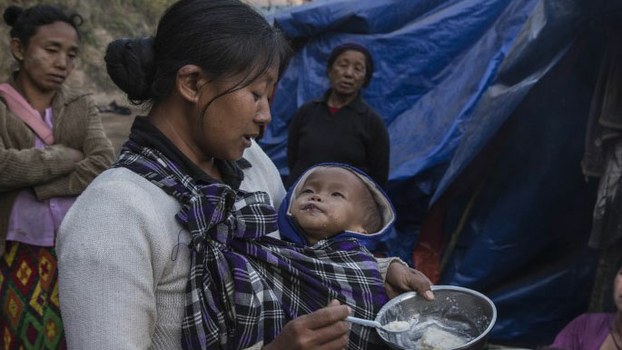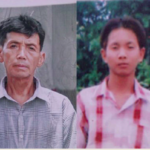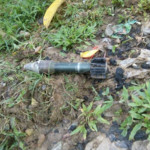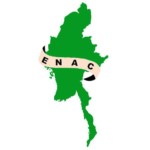By Kyaw Myo Min, Khin Khin Ei and Nay Rein Kyaw / Radio Free Asia (RFA) | April 19, 2018
Some 2,000 civilians in Myanmar’s war-torn Kachin state trapped in Tanaing township amid fighting between the national army and an ethnic militia are free to return home to their village, which has been cleared by the military, Kachin Chief Minister Khet Aung told RFA’s Myanmar Service on Thursday.
Myanmar’s army, meanwhile, told the villagers they cannot remain in Tanaing and would be forcibly returned to Awng Lat village, which they fled after fighting raged last week, according to The Irrawaddy online newspaper.
More than 2,000 ethnic Kachin villagers in Tanaing township have been homeless since April 11 after fleeing to nearby jungles to escape fighting between the military and Kachin Independence Army (KIA)
“The Command Commander of Northern Military Head Quarters has informed me that fleeing villagers from Awng Lawt Village can return home, as the military has cleared it and the village becomes normal,” Khet Aung told RFA in an interview.
“The state government and Red Cross members have begun our trip to the villagers with food and medicines,” the minister added.
According to The Irrawaddy, the army ordered the villagers to leave while offering them help getting home.
“We will not allow an IDP (internally displaced persons) camp for villagers who fled fighting in Awng Lawt village to open in the town. You must all go back and stay in your village,” said the news outlet, quoting a military announcement in Tanaing.
“We announce that we will offer all necessary assistance to enable you to resettle in your village,” the army said.
A spokesman for the KIA, however, disputed the safety claims made by the military and state minister. He said the army and KIA had deployed troops on the road from Tanaing to Awng Lawt village and were engaged in daily clashes.
“If they come back, the situation is not safe for them, as it is a war zone. There is no guarantee that local people will be safe,” The Irrawaddy quoted the KIA spokesman, Col Naw Bu, as saying.
“Even in Awng Lawt itself, the situation is not stable yet. Local people will face many problems if they come back,” he added.
Father Vincent, a Catholic priest who helps the displaced villagers, told RFA he did not think it was safe for the villagers to return.
“I think that they still have fear of returning home as fighting is still going on and they are still at risk with land mines,” he said.
The priest said 1,200 displaced villagers, including ten women in labor, more than 60 nursing mothers and many elderly people at a spot four hours walk from Tanaing.
“Food for them is enough for only a week,” he added.
A second religious worker, Christian leader Naw Taung, told RFA he was informed by military officials that the displaced villagers can go home.
But he said “We have lost contact with the IDPs since April 17.”
Fighting between the two sides resumed in early January when government soldiers launched air strikes in Tanaing, an area controlled by the KIA, which relies on its natural resources as a source of income by levying a tax on mine operators.
The KIA believes that Myanmar forces have been stepping up their attacks on rebel-held territory in hopes of gaining control of it before the next round of negotiations in the government’s peace conference initiative.
The KIA has engaged in skirmishes with the Myanmar army since 2011, when a 17-year bilateral cease-fire agreement between the two sides broke down.
The KIA is one of several militias with which the Myanmar government is trying to end decades of ethnic separatist civil wars and forge peace in the country through a series of peace talks launched in August 2016 by Myanmar leader Aung San Suu Kyi.
The Kachin Independence Organization (KIO), the KIA’s political wing, has not signed the government’s nationwide cease-fire agreement that eight of the country’s more than 20 ethnic armies inked in October 2015, with two more having joined since then.
This article originally appeared on RFA on April 19, 2018.






